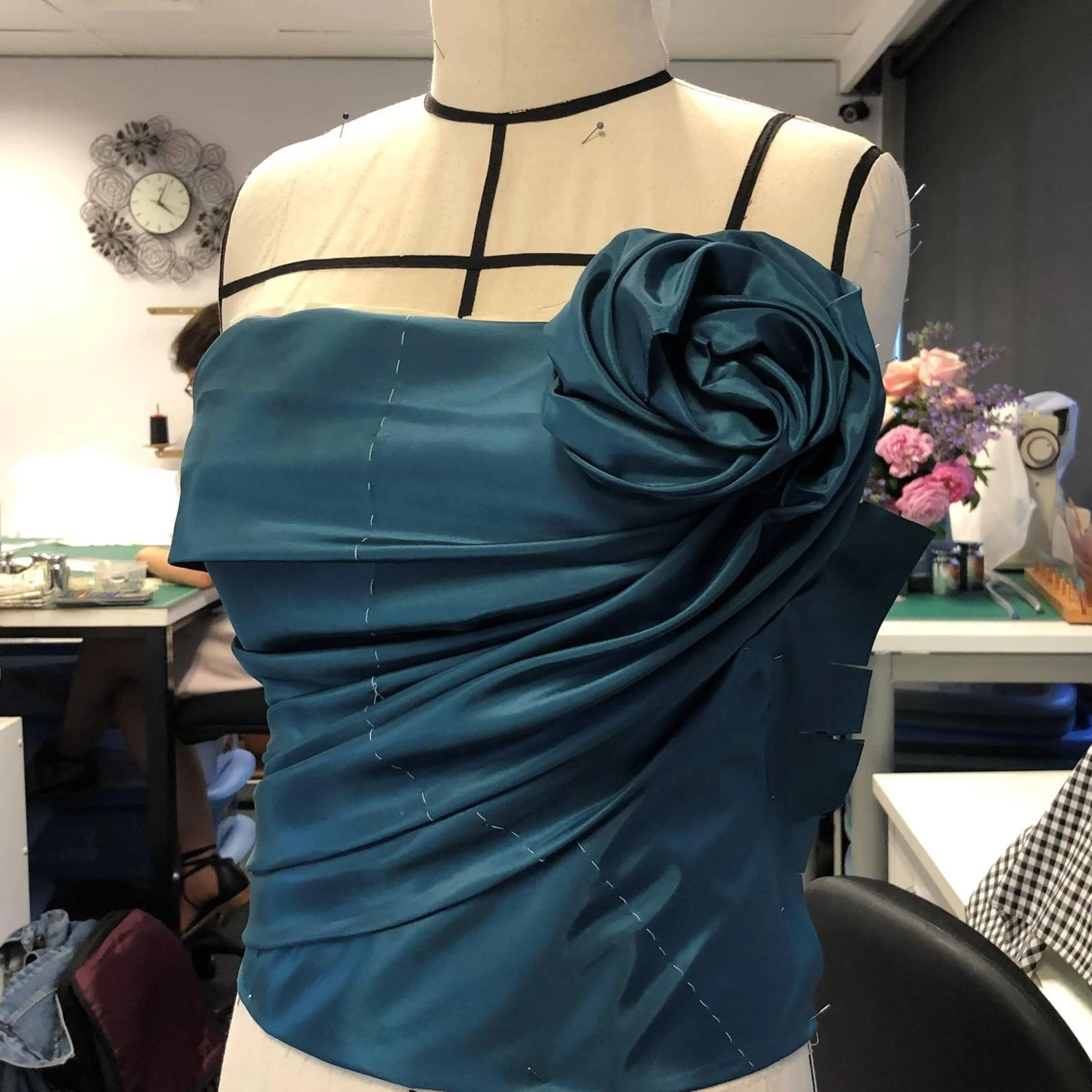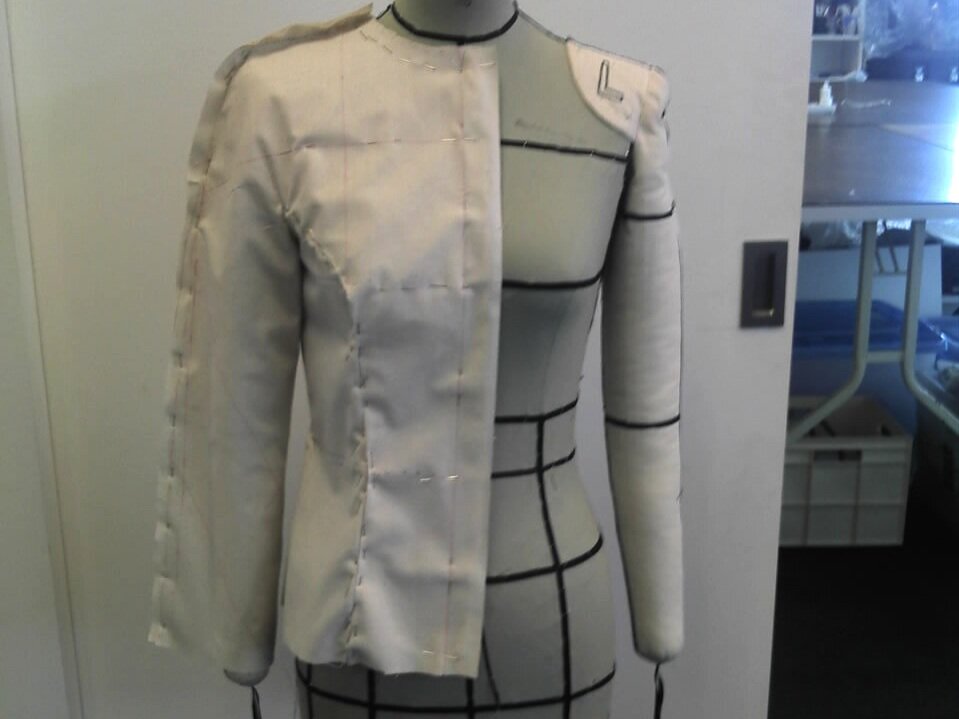Mid-Term Enrolments Welcome 〰️
Mid-Term Enrolments Welcome 〰️
DO YOU TOILE?
A few months ago, a printer repairer who was visiting the studio remarked that many of my students were sewing rather odd looking garments – all in the same very plain fabric. Of course he was referring to toiles or muslins (as they’re called in North America). I smiled as I explained what was going on but also (inwardly) lamented that so much of the hard work and genius that takes place in the studio isn’t exactly Insta-worthy!
So what is a toile and just how do you pronounce it?
A toile is a French word (pronounced twarhl) is a prototype or fitting version of a garment that’s made up in an inexpensive fabric so that the design can be tested and perfected. The name comes from the fabric of the same name that was originally used in their construction – a translucent linen or cotton fabric. These days, most toiles are constructed using calico or muslin. If you’ve accumulated a swathe of gorgeous fabrics in your stash but you’re too afraid to cut into your treasures, read on.
Is a toile the same thing as a muslin?
This is where it gets a tad confusing – especially for Trans-Pacific sewers. While a toile or a muslin are both test garments, muslin can also refer to the fabric that’s used to make it (especially in North America). A toile or a muslin can be made up in calico or muslin. I know, a little pedantic, but good to clear it up in the beginning.
Do you always use calico or muslin for a toile?
There are a number of reasons why calico or muslin is the go-to fabric choice for toiles. It’s inexpensive, it’s often available in larger widths, but most importantly, it’s a stable, woven fabric. This means that design flaws that may otherwise by obscured or camouflaged by a drapey fabric will be clearly visible. A neutral calico is also a good contrast for fitting and construction markings and you can even write your own notes on the toile. If you’re making a garment in a more fluid fabric (for example silk charmeuse or jersey), you would choose something less-expensive that mimics the hand or drape of your fashion fabric - for example this peach polyester crepe.
Toiles aren’t just for fashion designers.
Even if you’re mostly sewing from commercial patterns, either the “Big 4” (Simplicity, McCalls, Vogue or Butterick) or the many, many indie pattern makers (including our friends PaperCut, Cashmerette and Tessuti), the quality of your finished garment will be vastly improved if you make a toile first. Iron out those fitting kinks before even thinking of taking your scissors to the good stuff. Don’t be too hard on commercial patterns. If you think about it, how could it be possible to reduce the human race down to a handful of standard sizes and shapes?
It’s all about the fit.
Commercial patterns generally work from “average” body types, utilising B-cup pattern blocks and they’re often quite roomy, allowing plenty of ease. One of their main shortcomings is that the patterns are not marked with balance lines – vertical lines that should be parallel to each other and horizontal lines that should be perpendicular to the floor. On a toile, these balance lines are visible from the outside of the test garment, making it very clear where fitting adjustments are needed.
A toile gives you the confidence to try new techniques
I’ve seen so many sewers in the studio who are reluctant to expand their skillset and stick to the basics – which is fine – however ... for me, the point of sewing is to make something beautiful and unique and the sense of reward in completing a garment that will last for years. If you’ve never tried a welt pocket (and simply omit them from your jackets) a toile is the perfect place to start. I’ve also lost count of the number of students with a full bust who routinely choose a pattern size (or two) bigger and wonder why their finished garment resembles a shapeless sack. A toile will enable you to trial a number of techniques to achieve a perfect fit.
If you’re creating a new design, the pattern needs to be tested.
Essentially, a toile takes a 2D flat pattern and transforms it into a 3D garment to fit the body. One of the most important aspects of the process is to test and perfect sewing and finishing techniques and then determine the right sewing order. There’s a reason why patterns specify each sewing step in a specific sequence and when you start to design your own garments, you’ll quickly start to appreciate this. Sewers often find that their finished garment evolves in a different direction to their initial concept sketches and making a toile facilitates this. Even if you’re working from a tried and tested pattern block, new designs and details will emerge and a toile will show you what this will look like on a finished garment.
Keep notes and photos.
When your toile is coming together and you’re in the zone, there’s a tendency to assume that you’ll remember all of the steps in the process, not to mention all of the markings that you’ve made. My advice is to keep detailed notes for each toile and to supplement these with photographs (or visual notes – especially for the more complicated or intricate finishes or steps. Almost all of us have a smart phone at arm’s length, so there’s really no excuse not to do this!
Do you need your own dress form or dressmaker’s dummy?
If you don’t have someone who can help you with fitting (and it’s debatable how much “help” an ambivalent partner with pins really offers), a dress form is invaluable. Especially for fitting the back of a pattern. Dress forms also suffer from many of issues of commercial patterns (standardised, average body types), but some of them are adjustable or you may be lucky enough to conform to “fit model” measurements. Alas, this is really rare … from my experience, about 1 person in every 80-100. We currently have only one student in all of our classes who’s a fit model and we try really hard to conceal our envy : ) We also run a specialised class where you can make your own dress form to your personalised measurements.
Doesn’t it just add to the cost?
Sure. It absolutely does add to the overall cost of a garment, but in my experience, this is balanced out by the cost of throwaways, UFOs (unfinished objects) or mis-cuts … the sad failures we mournfully stash in the depths of our sewing rooms. There’s also the thrifty option of using old curtains or sheets – op shops are a good source for these. Who knows what else you might find – be sure to rummage for vintage patterns and buttons as well.
Is it worth the extra time?
You don’t have to make a complete toile for every garment you make (sometimes a quick result is what you’re after), but It’s such a great way to elevate your skills and turn “home-made” into “couture”. As a teacher, there’s nothing more satisfying to see an excited student complete the last stitch of a garment, try it on for a final time and say: “this is the best thing I’ve ever made”.
Say yes to the toile!















